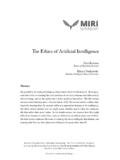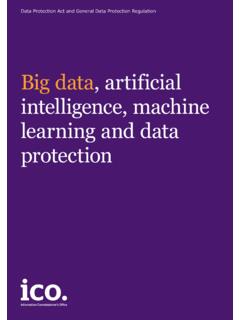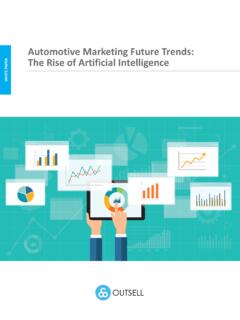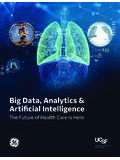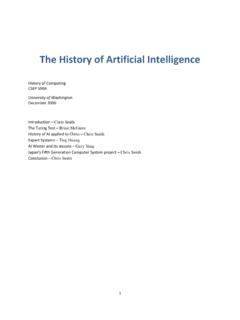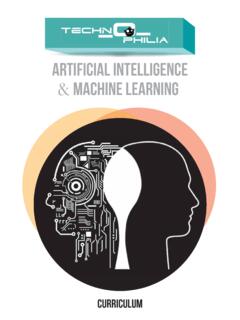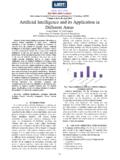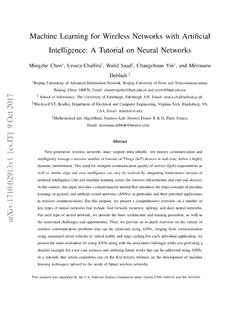Transcription of Artificial Intelligence Innovation Report - deloitte.com
1 Artificial IntelligenceInnovation ReportPowered by2018 Innovation Report 2018 IntroductionOver the past few years, deep learning has gone from an esoteric branch of AI, focusing on theory, to being so mainstream that even an actress from Twilight has published an academic paper on it. This rise of deep learning over traditional machine learning methods has also led to the creation of a host of new platforms designed to help businesses improve work and workflow. The idea of creating a machine that can think in a way similar to the human brain is as old as modern computing. In 1950, in his seminal paper Computing Machinery and Intelligence , computing pioneer Alan Turing laid out several criteria to assess whether a machine could be said intelligent, which has since become known as the Turing test . Thirty-six years later, computer scientist and cognitive psychologist Geoff Hinton demonstrated how an Artificial neural network with several layers could be trained to learn nonlinear functions.
2 In this model, each succeeding layer in the network learns from the previous layer. In 2006, Hinton devised a way to train similar networks to pass along only information related to specified parameters, adding and training new layers until a deep neural network was created. But it was the more recent appearance of large, high-quality labelled datasets, distributed computing and the applications of graphics processing unit (GPU) computing which has powered the recent, rapid advancement of deep learning. It is now possible to create deep learning neural networks which operate fast enough and accurately enough to have practical, real-world uses. Because of this, we are experiencing a paradigm shift in computing, an AI boom in which companies are spending billions to develop deep learning AI technology. Springwise has been following this shift since its beginning, and we have continually highlighted businesses at the forefront of the deep learning Springwise, we have found that, while there are a huge number of businesses that could benefit from deep learning, in general, for deep learning to offer a practical business solution, a company must have a need for finding complex relationships in large amounts of data, and a recurring need for predicting things that either cut costs or create value.
3 Some of the most relevant deep learning-powered business transformations we have found involve improved targeting of sales and marketing, better informed decision-making, increased productivity and automation of IntelligencePowered by2 Innovation Report 2018 IntroductionTargeted sales and marketingAI modelling and simulation techniques are already being used to help drive sales in a number of ways. Platforms providing real-time data gathering, forecasting, and trend analysis can offer greater insight into buyer behaviour. Artificial Intelligence used in conjunction with CRM systems can automate functions such as contact management, data recording and analyses, and lead ranking, while AI-enabled buyer modelling can provide a prediction of a customer s lifetime value. Recommendation systems are also used to learn content preferences and push content that fit those preferences, allowing more targeted sales.
4 While sales may appear to be primarily about relationships, in reality it is one of the most data driven areas of business. From names and contact numbers, to information on customer behaviour and purchasing, sales depends on the ability to find and identify the best sales leads, and the leads most likely to be converted. Traditionally, this information was collected by individual salespeople, but deep learning has allowed AI software to take over the time-consuming task of identifying contact information and lead scoring. Start-up Radius has spent years building a network-effect-driven data source called The Network of Record. The Network is built using data collected from more than 1 billion anonymized and aggregated business interactions. This data is then analysed by Radius AI software to provide Intelligence to sales teams which can help them directly target only the most qualified sales prospects for any pricing knowledge is a sales challenge faced by companies that operate in multiple markets around the world.
5 Local businesses can adjust prices based on local knowledge, but this is more difficult for businesses that operate globally, or whose customers are primarily online. In online shops, businesses tend to offer the same prices to every visitor, adjusted for local currency regardless of the competitiveness of their prices in different regions. While the sales team may be setting prices based on those of other online shops, customers may be comparing them to local alternatives the sales team may not even know about. Darwin Geo-Pricing has developed one solution to this, using a deep learning algorithm to retrieve the online shopper s location and combine this with data mining to adjust the prices each customer is offered. Darwin s machine learning system continuously performs exploratory pricing, offering different visitors higher or lower prices than others in the same location.
6 By comparing the sales performance at different price levels, Darwin can determine the optimal price level to pitch at each customer. Artificial IntelligencePowered by3 Innovation Report 2018 IntroductionAnother sales challenge is how to cut through the advertising noise and clutter most customers are faced with daily in order to deliver more personal and relevant content or products to each consumer. The Weather Company, which was purchased last year by IBM and rebranded as IBM Watson Advertising, is working to cut through this background ad chatter with the first-ever consumer use of IBM Watson AI technology for advertising purposes. Watson Ads uses natural language processing and machine learning to listen, think and respond to consumers questions with personalized answers in real time. Each Watson ad is able to understand the consumer s questions and respond in ways that sound like natural, human language.
7 Consumers clicking on a Watson ad for, say, a Toyota Prius Prime, can then interact with the ad to receive individualized answers to questions about the brand, other Toyota brands and automobile shopping. The program can also steer the conversation in a natural way, similar to how real people interact. Another approach to advertising made possible by machine learning algorithms is predictive advertising. Predictive advertising is a subset of predictive analytics, which uses machine learning to predict future outcomes based on behavioural patterns in historical data. In ad tech, predictive analytics is used to help businesses target audience segments based on behavioural signals, personalise ads to be more relevant to individual users, or optimise ad bids based on user data. There are a number of companies vying to develop platforms for predictive advertising, including Programmai, which uses AI to identify and target new prospects with ads based on what is already known about a company s existing customers or visitors.
8 The company s software can notify a business of how likely someone is to make a purchase, calculate future lifetime value, and automate ad bidding strategy decisions allowing companies to focus ads on where they will have the biggest similar approach is taken by Indianapolis-based Demandjump, which uses analytics to help marketers decide where to place ads in order to take advantage of up-to-the-minute trends. Their Artificial Intelligence marketing platform, dubbed TrafficCloud, collects data on page views, and can link customer activity across devices in order to present a detailed analysis of traffic between sources. The company s analytics can then pinpoint which sites have the greatest influence in a brand s competitive area, and which sites can help drive the highest number of customers to the brand. DemandJump s proprietary algorithms use machine learning, graph theory, algebraic topology, and natural language processing, to map each client s entire digital ecosystem and show marketers exactly what to do next to maximize revenue growth and stay ahead of market IntelligencePowered by4 Innovation Report 2018 IntroductionBetter decision makingBusiness decision making is a critical process, at all levels.
9 Many business experts suggest that the future of AI in executive decision-making actually lies in a partnership, with humans defining the questions to be asked, or problems to be tackled, and having a final say on the best answer for their business, while AI is used to analyse large volumes of data to provide a basis for the decision. For an example of why humans will not disappear from the decision-making process, we need look no further than Uber. When the companies AI pricing algorithm doubled ride prices in London during a major terror attack in 2017, the company suffered from the resulting bad publicity and accusations of price gouging. The algorithm is better at setting prices in real time than humans, but a human would have been more likely to realise that doubling prices during a tragedy is not good business. This partnership approach can be seen in the development of a number of recent AI decision-making platforms.
10 In Denmark, start-up Corti has developed an AI platform that listens in to phone calls to emergency services to help detect signs of a heart attack, including signals in verbal communication, tone of voice and breathing patterns. Corti compares the data from each call against millions of previous emergency calls to find patterns indicating a possible heart attack. Corti can then alert the dispatcher to the possible need for an ambulance. This early recognition is important because the chance of survival decreases by around 10 percent for each minute treatment is delayed after a heart attack occurs, and because many heart attack symptoms, such as shoulder pain, can be easily dismissed as a minor ailment. Partnership in decision making was also envisioned by the makers of VALCRI (Visual Analytics for sense making in Criminal Intelligence analysis), which is designed to aid the police and criminal investigators.










